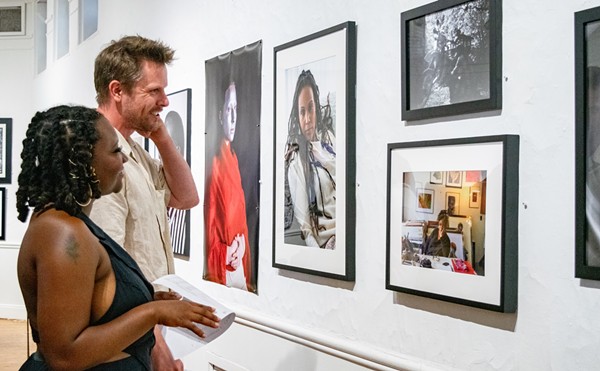The raw material for Cristin Richard’s art is a bit delicate, originally covered in salt. It’s rinsed, sorted, cut for assembly, pieced together and coated with a preservative. Normally, it would be used to make sausage. Richard uses pig intestines to make dresses.
She and Mary Rousseaux are two recent art grads who are developing their voices through innvoative technique. One of the nice things about being an artist in Detroit — and really, there are plenty of them besides cheap work space — is the opportunity to exhibit your work in a substantial show, even if you’re fresh out of school. Currently, Richard and Rousseaux are showing their work at Birmingham’s District Arts Gallery. The work may not demonstrate maturity or subtlety at the outset, but part of developing a critical eye (for both artist and collector) is learning to see, and seeing a lot.
Mary Rousseaux, a Wayne State MFA grad, makes abstract landscapes in encaustic, an ancient painting technique that involves folding pigment into hot wax. She works in layers of deep color and wash on board, letting the process erode in some areas and build up in others, suggesting the decay in nature that takes place beneath the surface. On most of her works, Rousseaux applies a final coat of shiny resin that adds density to the color migrating around in splashes and fields.
“Untitled Yellow #2” is a 4-square-foot work that demands attention upon entering the gallery space; it also has many lovely, quiet moments. Instead of applying resin to create an uninterrupted reflective surface, Rousseaux has painted open circles of dark reddish umber, like pocked craters erupting through the gloss. This bright moonscape also has bubbles captured within the resin that look like mountain ranges seen from outer space, similar to blurred satellite imagery. “Untitled White #4” is another Rousseaux beauty. In the foreground is a crusty white surface that brings forward thin layers of green, blue, orange and yellow paint, like a crumbling wall exposing its history.
A large untitled work, split in three horizontal bands of color, is reminiscent of sediment layers under the earth. The top section suggests the sublime depicted through dramatic light and epic scope by Hudson River School painter Frederick Church. Not all of Rousseaux’s compositions are equally successful. However, in an interesting twist of perception, she draws you into the illusion of the picture plane, and then, by exposing wooden edges of the canvas and covering it in drips, she reminds you that you are looking at fiction.
Cristin Richard’s choice of material — pig gut — is certainly less traditional. Richard, who received her bachelor’s degree from College for Creative Studies, slits them into ribbons, coats them with resin and then creates stiff, translucent dress forms.
Strangely, for the past 30 years, most undergrad programs in the country have had some fiber or sculpture students experimenting with gut, often exploiting the visceral quality of the skin to form hokey, shamanistic fetishes. Richard’s work is different; she transforms the material beyond recognition, yet manages to make it look fashionable. While her intention is a feminist statement on the roles women are forced to play, there’s tension between the forces of beauty and social agency, and it’s unclear which has the upper hand.
Still, the dresses may be too precious and conventional-looking to be convincing as ironic statements. They’re tame compared to the meat dresses of Canadian sculptor Jana Sterbak. But Richard’s art gets interesting when it’s more surreal, like when she creates human legs from the gut.
“Instigator I” is a tailored suit and mannequin legs, each hollow — and looking into the shell of a woman can be pretty unnerving. With “Easy Entry,” three sets of legs, detached from an upper body, rise from within layers of skirt, making them look like blooming roses. But here, unfortunately, her treatment of the mannequin legs feels like lost potential. If her idea just went more clearly one way or another — if the legs were weirder or more human, allowing for imperfection and vulnerability — they could more powerfully convey the psychological turmoil of her subject.
In its first year, District Arts has carved out a successful niche for itself balancing emerging talent with established artists. The gallery offers a diverse price range to collectors. This, and recognition of quality shows, may well mean long life for them.
Mary Rousseaux: New Paintings and Cristin Richard: Second Series, run through Oct. 15, at District Arts Gallery, 955 S. Eton, Birmingham; 248-258-9300.
Gerry Craig writes about art locally and nationally. Send comments to [email protected]




